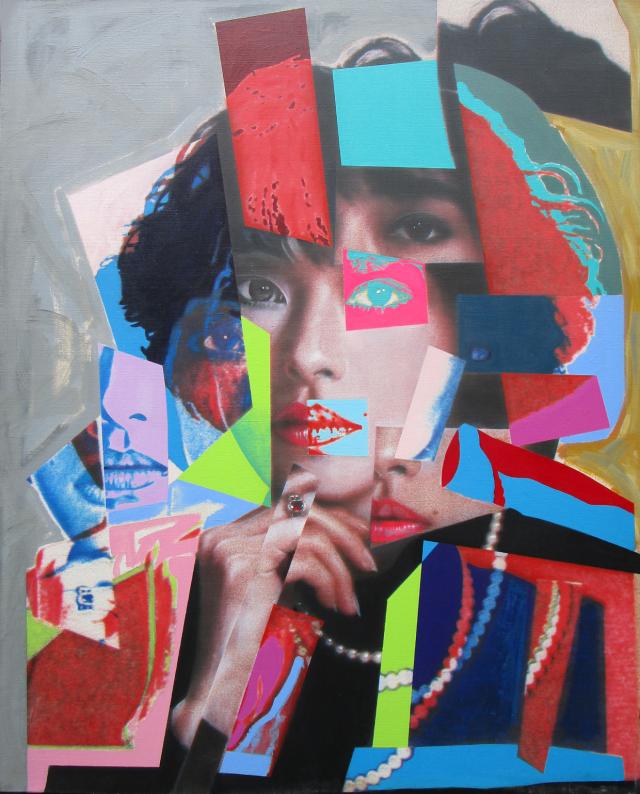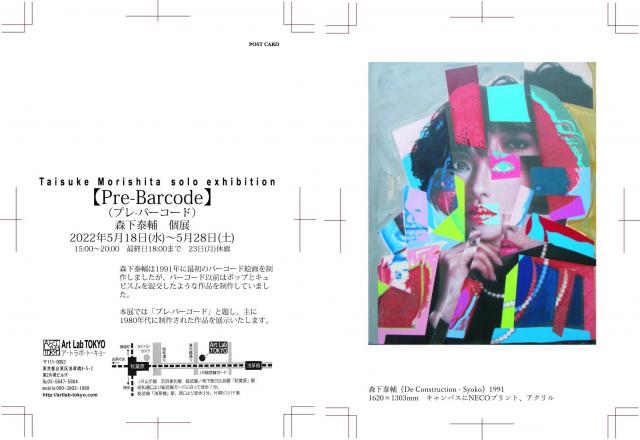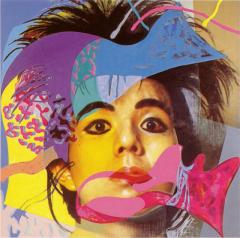Taisuke Morishita Solo Exhibition《Pre-Barcode》
森下泰輔 個展
Taisuke Morishita Solo Exhibition [Pre- Barcode]
5/18 wed. ~28 sat. 15:00~20:00 Last day ~18:00
5/23mon. 休廊
森下泰輔は1991年に最初のバーコード絵画を制作しましたが、バーコード以前はポップとキュビスムを混交したような作品を制作していました。本展では「プレーバーコード」と題し、主に1980年代に制作された作品を中心に展示いたします。
His back pages
天乃英彦(美術評論家)
思うままに作品行為としてともかくとっちらかして来、後ろを振り返らなかった森下だが、いよいよ過去を振り返り彼のアートとして整理をつけなければならない時がやってきた。齢98の森下の母がとうとう施設に入らなくてはならなくなったこともあるだろう。3年におよぶ新型コロナのまん延もあっただろう。そしてロシアのウクライナ侵攻で核の脅威が再び取りざたされ国連、NATOをはじめ世界がきな臭くなってきたこともある。
従来森下の動向を大雑把に分類すれば、札幌で道展画家の画塾に通っていた小学校低学年当時の1950年代、上京し10代であった1960年代、未成年ながら新宿風月堂に通い新宿で起こるハプニングを見てきた。中高時代は美術部ですでに美術家を志していた。美術予備校はお茶美でムサビに入ってからは即興を旨とする草創期のハードロックバンドを結成、ジャズ評論家の故・間章に誘われ、1972年「新潟現代音楽祭」でデビュー、それがNHK全国放送された。その意味では、森下は美術作品よりも先に音の表現があったといえるだろう。
「60年代の新宿中心にハプニングや前衛美術の動向を見てきましたが、美大に入った70年代はその肉体の氾濫ともいえるネオダダやゼロ次元のハプニングはいったん終息しており、共同体やヒッピーイズムがアートに影響を及ぼしていました。僕は絵具を音に変え表現することにしたのです」森下泰輔
だがこのことは複雑だ。森下が今日まで行っているノイズにしても、日本の美術界では一ジャンルを築いているとはいいがたい。森下は複数メディアにハイアートと同一の芸術表現の可能性を見ていたのだが。
「60年代美術最前線は絵画から離れていた。読売アンパン、ハイレッド・センターはすでにオフミュージアムな動向を示し、概念芸術やポップアートが華やかで、若い作家は次なる表現を模索していた」森下泰輔
結局、裸のラリーズ(1972年ムサビ「ZEROCK」で共演。森下がリーダーのロックバンドのドラマーはラリーズと掛け持ちしそのうち久保田麻琴と夕焼け楽団に入っている)、ロストアラーフらと行動をいつにした。同年結成されるサディスティック・ミカ・バンドから誘われるが、森下は自らのキャリアが美術から離れることを嫌い断っている。
「ラリーズとアラーフは当時でも比較的アートよりの音を出していたので集合的には同じ領域にいました」森下泰輔
そうはいっても森下は絵画も制作している。《サイケデリックな自画像》1975はその一枚である。当時のドラッグ文化の一端をうかがわせるトリップして描かれた自画像だ。だが、このサイケデリックは欧米においてもあくまでサブカルチャーであってハイアートの文脈に中心となる影響を及ぼしてはいない。そのため同作にあるのは幻覚のヴィジョンと同時にキュビスムを感じさせる。
「構成的な作品になってもいる。絵画の問題は小学生のころから一貫してあった。当時にしてもすでにカラーフィールドやミニマルが終わって、ポップを過ぎ、スーパーリアリズムになっていた。アルテポーヴェラやモノ派も台頭していたのだが、やはりアンディ・ウォーホルの動向が一番気になった。彼はファクトリーといわれるスタジオでもドラッグ文化とクロスしており、彼自体が何らかの現象であったことにひかれた」森下泰輔
アンディ・ウォーホル。現在からはうかがい知れぬ部分もあるが、先日亡くなった宮井陸郎は、「アンディ・ウォーホルにNYで出会ったら、あ、この人は悟っている。僕もアートをやる前に悟りを開かなければ、と思いインドに行った」という。
森下の場合は、ウォーホルの作品がポップエイジのデュシャンよろしくレディメイドイメージを採用していた上に、ハイアートに転換後は新聞写真を用いるなど、ジャーナリスティックであったため、一回生業としてジャーナリストになりマスコミで原稿を書いてみてアートを考えようとした。もともと音楽評論家としてクラフトワークやアシュラテンプルなどのレコードライナーノートを執筆していたため、マスコミ稼業は難なくこなせたという。いずれウォーホルというものは覚醒した人々の人生を狂わせ、あらぬ方向に向かわせて遠回りさせるのかもしれない。
「ジャーナリズムは写真とキャプションでできています。その頃現代美術はいわゆる“写真”的な見方ではない写真の使い方に目覚めていましたが、再度絵画を制作するのに写真と絵具を融合しようと試みました」森下泰輔
1980年代に入るとネオダダの記録を撮り、来日したウォーホルに密着した写真家、原榮三郎との付き合いの中で、再び絵画の制作を始めた。写真をベースに当時まだPCなどない時代にネコプリントでキャンバスに転写・構成して制作した。1985年から始まったこの現代アートの試みは今回の展覧会の軸を成している。
イギリスのロックスター、ダニエル・ダックスやアンナ・ドミノが来日の折、写真に収め、キャンバス作品に仕立てている。また同じ手法で中川比佐子肖像も制作している。だが、その構成原理にはやはりキュビスム的なるものが入り込んでいる。
「キュビスムもダダもコラージュが基本にある。バロウズ流にいうならカットアップです。同一平面上に時空を切り刻む。」森下泰輔
これらの手法は1950年代のラウシェンバーグらのネオダダにも顕著であって、ポストモダンとモダンをつなぐ唯一の原理はキュビスムとコラージュかもしれない。
1986年の作品《正方形のケラ》は、現在演劇界の重鎮となっているケラリーノ・サンドロビッチの肖像だが、フランク・ステラばりの抽象図形がコンバインされている。美術評論家・伊藤順二は同作を「ポップとニューペインティングの幸福な出会い」と評した。抽象と具象のコラージュ的構成を目指したものだ。
「当時のロックシーンはパンクを経てインディーズになっており、ケラのナゴムレーベルには密着しました。有頂天はアート的な側面もたくさん含んでいる運動体でした。」森下泰輔
80年代は、同時にビデオアートも複数制作し、いくつかはドイツZKMにパーマネントされている。その頃、欧米中心で展開していたハイアート系のビデオマガジン「インフェルメンタル」にも森下は何度か選ばれている。
「ビデオはタイムコラージュだといった白南準についていこうとしました。一度ビデオに映った人間は死ねないというパイクの言葉もあります。音、映像、絵画などすでに使用するメディアは拡張していました」森下泰輔
森下は1990年、宝島社の依頼で制作された「X(現X-JAPAN)」のポートレイトを描き終えると、この抽象と具象のコンバインの時代にいったん別れを告げた。世界がハイパー資本主義化し現れ出したバーコードを主題に据えたバーコードペインティングに移行し、90年代を通じて、草間彌生、今井俊満、美術評論家の日向あき子らとの交わりの中で、世界各国と交流をはじめ、シュレッダーを用いて紙幣をカットする「マネーカット」のパフォーマンスをモントリオール、パリ、ニューヨーク、ポーランドで行っている。
同時に90年代半ばからはインスタレーションに発展し、早くから天皇問題、戦争、日米安保問題、憲法などの政治的社会的主題で展開してきているほか、ギャラリーの運営にも乗り出したのだが、それは本論外なのでまた別のところで語ることとする。
森下泰輔 / Taisuke Morishita
Barcode を資本主義の象徴記号として活用している。武蔵野美術大学卒業。ヴェネチア・ビエ ンナーレ関連企画で展示のほか欧米(アメリカ、フランス、ポーランド、ドイツ、カナダ、イタリアなど)や中国・韓国などアジアで発表している。2010 年遷都 1300 年祭、平城宮跡で展示。2006 年ニューヨ ークで個展。2019 年 3 月アメリカ、イーストンでレジデンス&展示(IF Museum)。2021年 東京ビエンナーレ 優美堂プロジェクト(神田)。2022年 越後妻有 大地の芸術祭 2022メールアートプロジェクト。ホイットニービエンナーレ(ニューヨーク)で参加プロジェクトの資料展示。
Taisuke Morishita made his first barcode painting in 1990, but before the barcode he made a mix of pop and cubism. This exhibition, entitled "Pre-Barcode", will showcase works produced in the 1980s.
Taisuke Morishita Solo Exhibition [Pre-Barcode]
5/18 wed. ~ 28 sat. 15: 00 ~ 20: 00 Last day ~ 18: 00
5 / 23mon. Closed
His back pages
Hidehiko Amano (art critic)
Morishita did not look back, but it is time to look back and organize it as his art. One reason is that Morishita's mother in 98 years old may have to enter the facility. In addition, the Reason is that it would have had a three-year spread of the covid-19. And the reason is that Russia's invasion of Ukraine once again addresses the threat of nuclear weapons, putting the United Nations, NATO, and the rest of the world at risk.
Roughly classifying Morishita's trends, in the 1950s when he was in the lower grades of elementary school when he attended a children's cram art school in Sapporo, in the 1960s when he moved to Tokyo and was a teenager, He went to Shinjuku Fugetsudo. He had seen the happenings that happen. He was already aspiring to be an artist in the art club when he was in middle and high school. Before joining Musabi (Musashino Art University), the art preparatory school was Ochabi(Ochanomizu Art prep school). In Musabi he formed a hard rock band in the early days of improvisation and was invited by the late jazz critic Akira Aida to make his debut at the "Niigata Contemporary Music Festival" in 1972. His band was broadcast nationwide on NHK. In that sense, it could be someone who said that Morishita had an expression of sound before his work of art.
"I had seen the trends of happenings and avant-garde art in the center of Shinjuku in the 1960s, but in the 1970s when I entered art school, Neo-Dada and zero-dimensional happenings, which could be said to be the flooding of the body, had almost ended and passed, and the new trend grew up the community and hippieism. It had an influence on art. I decided to change the paint into sound and express it. "Taisuke Morishita
But this is complicated. Even with the noise that Morishita has been doing to this day, it is hard to say that noise has built a genre in the Japanese art world. Morishita had seen the possibility of the same artistic expression as high art in multiple media.
"The forefront of art in the 1960s was far from painting. Yomiuri Independent, Hi-Red Center was already showing off-museum trends, conceptual art and pop art was gorgeous, and young artists were looking for the next expression." Taisuke Morishita
In the end, he did act with Ralliez de Nude (co-starred in Musabi "ZEROCK" in 1972. Morishita's leading rock band drummer was with Ralliez and was the same as Makoto Kubota and the Sunset Orchestra), Lost Araff and others. He was invited by the Sadistic Mika Band, which was formed the same year, but Morishita refused to leave his career in art.
"Ralliez and Alaff were in the same area as a group because their sounds were relatively more to art at that time." Taisuke Morishita
Even so, Morishita also produced paintings. "Psychedelic self-portrait" 1975 is one of them. It was a self-portrait drawn on a trip that shows a part of the drug culture at that time. However, this psychedelic was a subculture in Europe and the United States and did not have a central influence on the context of high art. Therefore, what was in the same work is a vision of hallucinations and at the same time makes you feel cubism.
"It's also a constructive work. The problem with painting has been consistent since I was in elementary school. Even at that time, the color fields and minimalism had already ended, and it was past pop and became super-realism. Arte Povera and Mono-ha schools were also emerging, but Andy Warhol's movement was still the most worrisome. Warhol also crossed drug culture in a studio called a factory, and himself was some kind of phenomenon. I was particularly drawn to it. "Taisuke Morishita
Andy Warhol, there were some parts that are unclear from now, Rikuro Miyai, who died the other day, said, " I met Andy Warhol in NY 70s, he had been enlightenment of as "Satori" in Zen. So, I thought that I wish to get enlightened before doing my art, so I went to India. "
In the case of Morishita, Warhol's work adopted ready-made images like Duchamp of Pop Age, and after switching to high art, he used newspaper photographs and it was journalistic. So Morishita became a journalist as a first-time job. He tried to write a manuscript in the media and thought about art. Originally a music critic who wrote record liner notes for Kraftwerk or Ashla Temple, he said he was able to manage his mass media business effortlessly. Eventually, Warhol may upset the lives of awakened people and make them detour in a complex direction.
"Journalism is made up of photographs and captions. At that time, contemporary art was awakened to the use of photographs, which was not a so-called" photographic "view. So, I tried to combine photographs and paints to create paintings again." Taisuke Morishita
Photographer Eizaburo Hara who took a record of Neo-Dada organizers in the 60s, took photographs of Warhol in Japan in 1983. And Morishita started making paintings again while met with Warhol's photographer, Eizaburo Hara. Based on photographs, Morishita transferred and combined them on canvases with NECO prints when there was no PC at that time. This contemporary art attempt, which began in 1985, is at the heart of this exhibition.
When British rock stars Daniel Dax and Anna Domino came to Japan, He took pictures and made them into canvas works. He also produced portraits of Hisako Nakagawa in the same way. However, the cubist-like matter was still included in the composition principle.
"Cubism and Dadaism were basically collages. In the Burrows style, they were cut-ups. Cut up space-time on the same plane." Taisuke Morishita
These techniques are also prominent in the 1950s Rauschenberg etc. The only principle connecting postmodernism to modernism may be cubism and collage.
The work of 1986 "Kera in Square" is a portrait of Keralino Sandrovich, who is now a major figure in the Japanese theater world, but it is a combination of Frank Stella-like abstract elements. Art critic Junji Ito said the work as "a happy encounter between pop and new painting." The aim was to create a collage-like composition of abstract and concrete.
"The rock scene at that time became indies after punk, and I was in close contact with Kera's Nagomu label. Kera's band "Ucho-ten" was a movement that also included a lot of artistic aspects." Taisuke Morishita
In the 1980s, he also produced many video arts at the same time, some of which are permanent collections to ZKM in Germany. At that time, Morishita was selected several times by the high-art video magazine "Infermental," which was developed in Europe and the United States.
"I tried to keep up with Nam June Paik, who said that video is a time collage. There were also Pike's words that humans are once shown in the video will not die. The media already used, such as sound, video, and painting, I had expanded." Taisuke Morishita
Morishita once finished painting a portrait of "X (now X-JAPAN)" produced at the request of Takarajimasha in 1990, and once said goodbye to this era of abstract and realism combined harvesters. Throughout the 90s, He had talked with Yayoi Kusama, Toshimitsu Imai, and Akiko Hyuga, an art critic, moved to a painting with the theme of barcodes that emerged as the world became hyper-capitalism. Starting with exchanges with various countries, he has performed "money cut" performances in Montreal, Paris, New York, and Poland, where he cuts paper bills using a shredder machine.
At the same time, it developed into an installation from the mid-1990s, and from an early stage, it developed on political and social themes such as the Emperor issue, war, Japan-US security issues, and the Constitution. Also, in the 21st century, the gallery operation started. But it is outside this exhibition. I will talk about that elsewhere.








